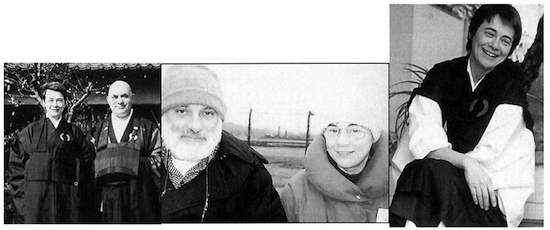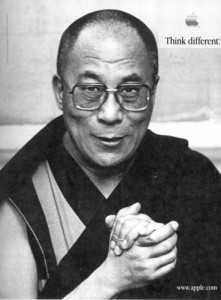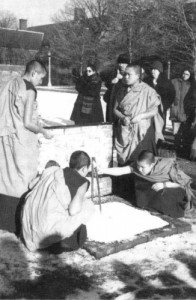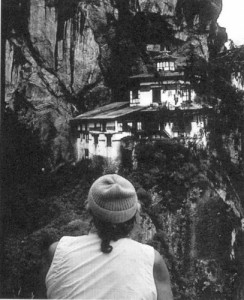In Memorium: Jishu Holmes
Zen teacher Sandra Jishu Angyo Holmes died of heart failure on March 20 in Albuquerque, New Mexico, at age fifty-seven. Sensei Holmes, together with her husband, Roshi Bernie Glassman, co-founded the Zen PeacemakerImage 4: The late Dilgo Khyentse Rinpoche at Paro Taktsang, date unknown. Photo © Matthieu Ricard. Order, which emphasized meditation, engaged spirituality, and interfaith expression.

From 1982 to 1998, Jishu Holmes and Bernie Glassman founded and developed the Greyston Mandala in Yonkers, New York, a group of non-profit and for-profit companies dedicated to improving the lives of inner-city people. She served as the first Executive Director of Greyston Family Inn, which provided permanent housing and services for homeless families, and with her husband developed a model that encouraged homeless families to move into permanent housing and supported them with long-term services that would take them from welfare dependency to economic self-sufficiency. She also developed the initial programs for Issan House and the Maitri Day Program, housing and health services for people with HIV and AIDS in Yonkers. After living for fifteen years in Riverdale and Yonkers, New York, the couple had moved to Santa Fe, New Mexico, in the Spring of 1998, arriving just days before her death.
Born in Oakland, California, in 1941, Jishu earned a Ph.D. in biochemistry from Columbia University in 1976, and completed a postdoctoral fellowship in human genetics at Mount Sinai Hospital in New York City. She was ordained as a Zen priest in 1983 by Roshi Glassman and in 1995 received dharma transmission.
In 1992, Jishu wrote in her journal: “I’m beginning to see how hard I’ve worked to free myself of my conditioning that I’m inadequate, not worthwhile, unlikeable. How important it is to like myself first and to have compassion for myself. To love and embrace that person who is trying so hard to be a full human being.” Shortly before her death, another journal entry read: “Only the wounded healer is able to heal. As long as we think that spiritual leaders need to be perfect, we live in poverty. I have a perfect teacher inside; there is no perfect teacher outside.”
Put This in Your Pipe
Protestors have upped the ante in the ongoing fight against the Yadana Gas Developing Consortium, whose multimillion-dollar oil pipeline is disrupting both wildlife and village life along the Thai-Burmese border in southwestern Thailand. The prominent social critic and Buddhist activist Sivak Sivaraksa has vowed to continue his protest of the pipeline despite his arrest in March for obstructing construction at the project site in Kanchanaburi.
The onetime Nobel Peace Prize nominee joined a host of conservationists camped out in the Huay Kayeng Forest in an effort to halt the encroachment of bulldozers. Sivak, who is sixty-five, faces a six-month jail term or a fine of 1,000 Baht fine ($20,000) if convicted. The activist is filing a countersuit against the Petroleum Authority of Thailand (PTT), and declares that he will “fight until the project is scrapped.”
Wisdom Tooth
A 2,400-year-old tooth, one of three that Buddhists say were found after the Buddha’s cremation, was recently donated to Fu Kuang Temple in Kaohsiung, Taiwan. The relic, originally kept in Tibet, was moved to India during the Chinese Cultural Revolution of the 1970s. Senior Tibetan monks were no longer confident that the tooth could be protected from vandalism in India.
Taiwanese officials resisted pressure from Beijing to have the Buddha’s tooth sent to China. Wu Poh-hsiung, an advisor to the President of Taiwan, said the sacred relic will bring peace to Taiwan and “purify the public mind polluted by greed.”
The relocation of the vestige coincides with the hurried rebuilding of another reliquary of a Buddha tooth. In Kandy, Sri Lanka, a Buddhist shrine was the target of a Tamil Tiger rebel bomb attack which killed thirteen people and injured twenty-three. The temple’s entrance and roof were damaged by the blast, but the inner chamber that housed the relic remained intact.
Thinking Different?

“We were impressed by the fact that a major United States corporation chose to stand up behind the image of His Holiness at a time when many large corporations prefer to distance themselves from the Tibetan issue for fear of angering China,” said Dawa Tsering, the official representative of the Dalai Lama in America. He added that the message “Think Different” reflects the characteristics of His Holiness. The Tibetan refugee community in India received a donation of $20,000 worth of computer equipment from Apple.
Buddhists around the country have flooded Apple Computer with both congratulatory and concerned queries in response to the ad campaign. In an open letter to Apple Computer, two Buddhist filmmakers, Jonathan Blank and Barclay Powers, called the appropriation of the Dalai Lama’s image an “unconscionable commercial exploitation of a man who has devoted his life to the spiritual path.”
Mending the Dharma Leak
For two days in April, Japan became the brain trust of Buddhism when more than a dozen Asian Buddhist leaders, including the Dalai Lama, converged for the First World Buddhist Propagation Conference to address the problem of Asia’s dwindling interest in Buddhism. “Buddhism is on the decline in South Korea, Malaysia, and Taiwan,” said K. Sri Dammananda Maha Thera, a Malaysian priest who attended the meeting. “Every day we are losing our youth to Christianity.” In a joint statement, the participants vowed to promote the restoration of seven sacred sites in India and one in Nepal.
One of the causes of Buddhism’s waning presence in Asia, noted conference participants, is the long history of disagreements between sects – which didn’t end with the conference. In fact, none of Japan’s predominant sects were in attendance, held to coincide with the celebration of the Buddha’s birthday. “It is very disappointing that we were not invited to join,” said Junna Nakada, abbot of Daigo-ji, one of Kyoto’s renowned temples. Japan was represented by a new and largely unknown sect called the Nembutsushu, which co-hosted the conference.
Women’s Work

Tibetan nuns are showing their colors – creating the brilliantly hued sand mandalas that once were the strict province of men. In March, at Trinity College in Hartford, Connecticut, seven young Gelugpa nuns from the Keydong Thuck-Chen-Cho-Ling Nunnery in Kathmandu constructed a vivid five-color mandala, ten feet in diameter with raised components, symbolizing the palace of Avalokiteshvara, the Bodhisattva of Compassion. It was the first mandala ever made by women in the West, and one of very few made by women ever.
The nuns, who range in age from eighteen to twenty-five and who were born in refugee villages in India and Nepal, worked intensively for two weeks to complete the mandala as part of a conference entitled “Women Changing Buddhism,” sponsored by Trinity College. They are the first generation of female sacred artists to be recognized by the Gelugpa lineage. They began studying sand mandala making in 1993 under the tutelage of monks from southern India and have since completed a new mandala every six months. Other Tibetan nuns are now practicing this art form, along with thangka painting and debate – skills that were also previously used to be taught only to monks – as part of their spiritual education.
Faith in Translation
Dennis Hirota, a translator and California native, may be one of Buddhism’s most dedicated interpreters. Twenty-six years ago, Hirota visited Japan to sample the culture of a Buddhist country. In the intervening quarter-century, he has completed a two-volume, 1,000-page English translation of the collected works of Shinran (1173-1263), the founder of the Jodo Shinshu sect of Pure Land Buddhism. “I planned to stay only one year, but the translation eventually became my life’s work,” said Hirota, 51.
The translation is an important introduction of Jodo Shinshu to the West.
A Monastery Lost

On Sunday, April 19, Bhutan’s Paro Taktsang Monastery, or Tiger’s Nest, one of the oldest and most sacred shrines in the Himalayan world, was consumed by fire and destroyed. At least three of a handful of residence monks were crushed to death when giant rocks, loosened by the intense heat of the blaze, fell from the mountain face behind the temple. The cause of the fire is under investigation.
Built on the face of a spectacular 2,500-foot-cliff, Taktsang has existed since the ninth century, when Padmasambhava, the founder of Tibetan Buddhism, is said to have flown to a cave at the site on the back of a tiger. There, he gave teachings and initiations to his disciples and then concealed other teachings, or termas, meant to be rediscovered and spread at appropriate times in history.
Taktsang was laden with an extraordinary collection of early Buddhist art and relics, including thangkas, status, paintings, and scriptures. The wooden buildings that burned were built over a network of caves in the seventeenth century. In modern times, great Tibetan masters such as Kangyur Rinpoche, Dudjom Rinpoche, and Dilgo Khyentse Rinpoche revealed termas there. On one visit, Khyentse Rinpoche wrote of the exquisite shrine:
Towering mountain clad in a virgin
forest
Your peak, majestic in its snowy
turban,
Stretches to the skies.
Your chest is draped with silvery
scarves of mist;
How happy the carefree yogi who
Lets go of this life’s affairs!
Plans are underway to rebuild the monastery.
The Wheel
Niwano Peace Prize: Awarded to the Supreme Patriarch of Cambodian Buddhism, Maha Ghosananda, for his efforts to promote reconciliation among the Cambodian people.Bukkyo Dendo Kyokai 1998 Cultural Award: To poet Gary Snyder, in honor of his literary contribution to “worldwide appreciation of Buddhism.” In the first event of its kind ever, His Holiness the Dalai Lama and Ven. Mater Sheng-yen spent the first weekend in May at Roseland in New York discussing Tibetan and Chinese Wisdom teachings for an audience of 2,500 (see the Tricycle Hub for online coverage). When the Buddha talked about crossing over to the other shore, he didn’t have travelers checks in mind, but apparentlyMasterCard does and uses a Buddha image as its logo in a new ad campaign. Sanghas around the United States continued the tradition of celebrating Vesak, the Buddha’s birthday in April and May with services, lantern-lit processions, and cultural pageantry including, on May 23 in New York City, a festival at St. Peter’s Church. On April 23, the Greyston Foundation opened its newest apartment complex for formerly homeless families in a remodeled building in Yonkers, New York. Walking meditation? Designer Donald Pliner’s platform wedge sandal, “Buddha,” is available at Bloomingdale’s; for a sportier look, Adidas offers the “Nirvana.”